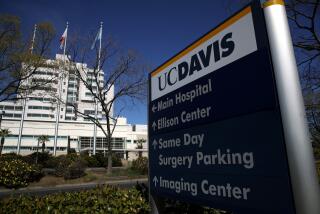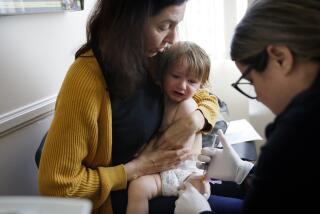An Early Dose of Prevention
- Share via
A new state law that took effect this summer mandates that students cannot enter, advance to or repeat the seventh grade if they have not started the three-dose hepatitis B series, administered over four to six months.
The new law is intended to catch older children who missed earlier inoculations and are approaching the years when the disease is often contracted.
Officials said many children don’t get the immunization shots they need on time. One out of every three children in Orange County between birth and the age of 2 is far behind on immunization injections, officials said.
Recommended Childhood Immunization Schedule
Approved by the Advisory Committee on Immunization Practices, theAmerican Academy of Pediatrics and the American Academy of FamilyPhysicians.
Hepatitis B
First Dose: Birth to 1 month
Dose 2: 1 month to 6 months
Dose 3: 12 months to 15 months
Catch-up*: 11-12 years
**** Diptheria, Tetanus, Pertussis
Dose 1: 2 months
Dose 2: 4 months
Dose 3: 6 months
Dose 4: 15 to 18 months
Dose 5: 4-6 years
Tetanus and Diptheria booster: 11-12 years, 14-16 months
**** H. influenza type B
Dose 1: 2 months
Dose 2: 4 months
Dose 3**: 6 months
Dose 3/4: 12 months to 15 months
****
Polio
Dose 1: 2 months
Dose 2: 4 months
Dose 3: 12 months to 15 months
Dose 4: 4-6 years
****
Measles, Mumps, Rubella
Dose 1: 12 months to 15 months
Dose 2: 4-6 years, 11-12 years
****
Varicella***
Dose 1: 12 months to 18 months
Catch-up*: 11-12 years
Updates
Hepatitis B
Now required for entry into kindergarten or any licensed child careprogram. As of July 1, 1999, is required for students entering oradvancing to the seventh grade.
Pertussis (whooping cough)
So-called acellular vaccine may now be given for all five doses.Whole-cell vaccine previously given to infants was associated withserious side effects.
Polio
Oral vaccine, shot or a combination of the two is now acceptable.
Measles
Second dose is now required of all children entering kindergarten.
Varicella (chickenpox)
Licensed by the government in March 1995. One dose may be given anytime after first birthday. For those 13 or older, two doses needed.
* Given to those not previously vaccinated.
** Third dose is not needed if PedvaxHIB vaccine by Merck is used.
*** May be given any time after first birthday. Not required forschool entry.
Sources: Centers for Disease Control and Prevention, American Academy of Pediatrics.
How Vaccines Work
A 1796 experiment by British physician Edward Jenner led to theworld’s first vaccination. He inserted matter from a dairymaid’s cowpoxsore into the arm of a healthy boy, who then caught cowpox, a minordisease. When Jenner put smallpox matter into the boy’s arm 48 dayslater, he didn’t catch the potentially fatal disease.
1. A vaccine containing a live weakened or dead disease germ is given by injection or as a liquid in the mouth.
2. The immune system is provoked to make antibodies to fight theweakened or dead germs.
3. Antibodies practice on the weak germs so when the real germs invadea body, the antibodies will know how to destroy them, and the illnesswill not take hold.
4. If the real microorganism enters the body, the antibodies areproduced in large numbers to stop the infection. Most vaccines begin toprovide immunity in about two weeks. However, many vaccines requirebooster shots to ensure continued immunity.
Immunization rates by state
Percentage of children, 19-35 month olds, immunized as of 1996:
Top 5 States
1. Connecticut: 88%
2. Maine: 87%
3. Massachusetts: 87%
4. South Carolina: 86%
5. Vermont: 86%
****
Bottom 5 States
46. Oregon: 72%
47. West Virginia: 72%
48. Nevada: 71%
49. Idaho: 68%
50. Utah: 64%
California: 78%
U.S. average: 78%
Cases of Vaccine-Preventable Diseases Nationwide 1996
Diphtheria: 1
Measles: 488
Mumps: 658
Pertussis (whooping cough): 6,467
Polio (paralytic):
Rubella (German measles): 210
Congenital Rubella Syndrome: 2
Tetanus: 27
Hepatitis B: 9,994
Haemophilus influenzae type b: 276
Varicella (chickenpox): 3.9 mil.
Free Vaccines
It costs the uninsured about $318 to fully vaccinate a childthrough a private doctor--just for the serum alone--not including thecost of office visits. What if you can’t afford it? The followinghotlines for a referral to a free vaccination clinic.
Los Angeles County vaccination hotline: (800) 427-8700 (multiplelanguages)
CDC’s National Immunization Information hotline: (800) 232-2522(English); (800) 232-0233 (Spanish)
Sources: Center for Disease Control and Prevention, Immunization Branch of the California Department of Health Services, Los Angeles County Department of Health Services, American Academy of Pediactrics, World Book, staff reports. Researched by STEPHANIE STASSEL/ Los Angeles Times
More to Read
Sign up for Essential California
The most important California stories and recommendations in your inbox every morning.
You may occasionally receive promotional content from the Los Angeles Times.










